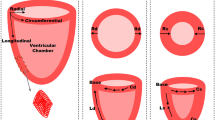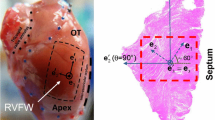Abstract
The myocardium is composed of a complex network of contractile myofibers that are organized in such a way as to produce efficient contraction and relaxation of the heart. The myofiber architecture in the myocardium is a key determinant of cardiac motion and the global or organ-level function of the heart. Reports of architectural remodeling in cardiac diseases, such as pulmonary hypertension and myocardial infarction, potentially contributing to cardiac dysfunction call for the inclusion of an architectural marker for an improved assessment of cardiac function. However, the in-vivo quantification of three-dimensional myo-architecture has proven challenging. In this work, we examine the sensitivity of cardiac strains to varying myofiber orientation using a multiscale finite-element model of the LV. Additionally, we present an inverse modeling approach to predict the myocardium fiber structure from cardiac strains. Our results indicate a strong correlation between fiber orientation and LV kinematics, corroborating that the fiber structure is a principal determinant of LV contractile behavior. Our inverse model was capable of accurately predicting the myocardial fiber range and regional fiber angles from strain measures. A concrete understanding of the link between LV myofiber structure and motion, and the development of non-invasive and feasible means of characterizing the myocardium architecture is expected to lead to advanced LV functional metrics and improved prognostic assessment of structural heart disease.
Access this chapter
Tax calculation will be finalised at checkout
Purchases are for personal use only
Similar content being viewed by others
References
Avazmohammadi, R., et al.: A computational cardiac model for the adaptation to pulmonary arterial hypertension in the rat. Ann. Biomed. Eng. 47(1), 138–153 (2018). https://doi.org/10.1007/s10439-018-02130-y
Avazmohammadi, R., Hill, M., Simon, M., Sacks, M.: Transmural remodeling of right ventricular myocardium in response to pulmonary arterial hypertension. APL Bioengineering 1(1), 016105 (2017)
Barbarotta, L., Bovendeerd, P.H.M.: A computational approach on sensitivity of left ventricular wall strains to fiber orientation. In: Ennis, D.B., Perotti, L.E., Wang, V.Y. (eds.) FIMH 2021. LNCS, vol. 12738, pp. 296–304. Springer, Cham (2021). https://doi.org/10.1007/978-3-030-78710-3_29
Barbarotta, L., Bovendeerd, P.H.M.: Parameter estimation in a rule-based fiber orientation model from end systolic strains using the reduced order unscented Kalman filter. In: Ennis, D.B., Perotti, L.E., Wang, V.Y. (eds.) FIMH 2021. LNCS, vol. 12738, pp. 340–350. Springer, Cham (2021). https://doi.org/10.1007/978-3-030-78710-3_33
Buckberg, G., Hoffman, J.I., Mahajan, A., Saleh, S., Coghlan, C.: Cardiac mechanics revisited: the relationship of cardiac architecture to ventricular function. Circulation 118(24), 2571–2587 (2008)
Ferreira, P.F., et al.: In vivo cardiovascular magnetic resonance diffusion tensor imaging shows evidence of abnormal myocardial laminar orientations and mobility in hypertrophic cardiomyopathy. J. Cardiovasc. Magn. Reson. 16(1), 1–16 (2014)
Geerts, L., Kerckhoffs, R., Bovendeerd, P., Arts, T.: Towards patient specific models of cardiac mechanics: a sensitivity study. In: Magnin, I.E., Montagnat, J., Clarysse, P., Nenonen, J., Katila, T. (eds.) FIMH 2003. LNCS, vol. 2674, pp. 81–90. Springer, Heidelberg (2003). https://doi.org/10.1007/3-540-44883-7_9
Keshavarzian, M., et al.: An image registration framework to estimate 3D myocardial strains from cine cardiac MRI in mice. In: Ennis, D.B., Perotti, L.E., Wang, V.Y. (eds.) FIMH 2021. LNCS, vol. 12738, pp. 273–284. Springer, Cham (2021). https://doi.org/10.1007/978-3-030-78710-3_27
Mendiola, E., et al.: Contractile adaptation of the left ventricle post-myocardial infarction: predictions by rodent-specific computational modeling. Ann. Biomed. Eng. 16(2), 721–729 (2022)
Mendiola, E.A., et al.: Right ventricular architectural remodeling and functional adaptation in pulmonary hypertension. Circulation: Heart Failure 16(2), e009768 (2023)
Pluijmert, M., Delhaas, T., de la Parra, A.F., Kroon, W., Prinzen, F.W., Bovendeerd, P.H.: Determinants of biventricular cardiac function: a mathematical model study on geometry and myofiber orientation. Biomech. Model. Mechanobiol. 16(2), 721–729 (2017)
Scott, A.D., et al.: An in-vivo comparison of stimulated-echo and motion compensated spin-echo sequences for 3 T diffusion tensor cardiovascular magnetic resonance at multiple cardiac phases. J. Cardiovasc. Magn. Reson. 20(1), 1–15 (2018)
Stoeck, C.T., Von Deuster, C., Genet, M., Atkinson, D., Kozerke, S.: Second-order motion-compensated spin echo diffusion tensor imaging of the human heart. Magn. Reson. Med. 75(4), 1669–1676 (2016)
Walker, J.C., et al.: Helical myofiber orientation after myocardial infarction and left ventricular surgical restoration in sheep. J. Thorac. Cardiovasc. Surg. 129(2), 382–390 (2005)
Welsh, C.L., DiBella, E.V., Hsu, E.W.: Higher-order motion-compensation for in vivo cardiac diffusion tensor imaging in rats. IEEE Trans. Med. Imaging 34(9), 1843–1853 (2015)
Zhang, X., Haynes, P., Campbell, K.S., Wenk, J.F.: Numerical evaluation of myofiber orientation and transmural contractile strength on left ventricular function. J. Biomech. Eng. 137(4), 044502 (2015)
Acknowledgements
This research was supported by the NIH Grant No. R00HL138288 to R.A..
Author information
Authors and Affiliations
Corresponding author
Editor information
Editors and Affiliations
Rights and permissions
Copyright information
© 2023 The Author(s), under exclusive license to Springer Nature Switzerland AG
About this paper
Cite this paper
Usman, M. et al. (2023). On the Possibility of Estimating Myocardial Fiber Architecture from Cardiac Strains. In: Bernard, O., Clarysse, P., Duchateau, N., Ohayon, J., Viallon, M. (eds) Functional Imaging and Modeling of the Heart. FIMH 2023. Lecture Notes in Computer Science, vol 13958. Springer, Cham. https://doi.org/10.1007/978-3-031-35302-4_8
Download citation
DOI: https://doi.org/10.1007/978-3-031-35302-4_8
Published:
Publisher Name: Springer, Cham
Print ISBN: 978-3-031-35301-7
Online ISBN: 978-3-031-35302-4
eBook Packages: Computer ScienceComputer Science (R0)




